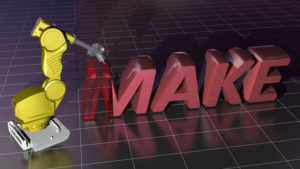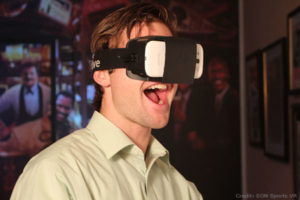
As if scripted for a “Star Trek” episode, news of a real-life, real-time hologram instantly projected images of holodecks in many a sci-fi fan’s head, only to be dashed and challenged and revived again. The action opened with an announcement that a technological breakthrough by researchers at The University of Arizona produces a true hologram — one that can be viewed from any angle and without 3D glasses. Finally an image not projected CNN style, via bluescreen, but definitely, physically produced at a summoner’s request. But wait, say the researchers.
“It’s not exactly like the holodeck, since the people were floating in air without any support screen in the ‘Star Trek’ movie,” explained Pierre-Alexandre Blanche, Ph.D., an assistant research professor in the College of Optical Sciences at The University of Arizona and lead author of the research paper published in Nature.
“The same for the iconic ‘Star Wars’ Princess Leia. Photons that stop in thin air to reproduce an image are as much science fiction as time travel and faster-than-light speed,” Blanche told TechNewsWorld.
OK, so the science is not of the R2-D2 or holodeck-ilk, it’s still pretty mind-blowing.
“The hologram shows multiple perspectives, so when you move around, you can see different aspects of the object like in real life — something 2D would never be able to do,” said Blanche. “And, if we succeed to demonstrate videorate, a two-way system will allow eye contact with the audience.”
Cool stuff, this moving, interactive hologram that can look at you while you look at it! But yeah, a screen will be there too.
“Holograms need a support — a screen to look at. It is like a window where you see the image when you look through,” explained Blanche. “The exception is that the image can be projected in front of the ‘window’ in the case of the hologram.”
Holo Duels
Not so fast, says a voice over the din of cheering crowds.
“Recent work published by a University of Arizona research laboratory is interesting, but their approach possesses fundamental limitations for true real-time holographic display that have been already been overcome elsewhere, including here at Zebra Imaging,” Michael A. Klug, CTO of Zebra Imaging, told TechNewsWorld.
Practical holographic teleconferencing, television and telemedicine require updates at more than 15 frames per second, scalability to various sizes, full-parallax to enhance realism and eliminate viewing discomfort, and a wide angle of view to accommodate multiple users, Klug pointed out.
“A high-efficiency, dynamic, electronic 3D display with no moving parts is the basis of a more practical approach, and is embodied in Zebra’s ZScape Motion Holographic Display technology,” he said.
“Zebra demonstrated full-parallax holographic motion displays to audiences at the USGIF GEOINT 2008 Conference and a real-time ‘holographic telepresence’ application on the display at the 2009 GEOINT conference,” notes Mark Lucente, director of motion display products for Zebra Imaging, in its official response to the University of Arizona’s announcement. “Earlier this year we publicly announced an agreement to integrate the Zscape Motion Display product into specific customer applications.”
What? You mean there’s more hologram technology already lying around? Good. Bring on the holodecks!
Dueling Screens
So, OK, no holodecks yet, physics being the grand restrainer that it is. So what hologram technologies do we have to choose from today?
The University of Arizona’s screen is made out of a photorefractive material capable of refreshing holograms every two seconds, making it “the first to achieve a speed that can be described as quasi-real-time” according to Blanche. The prototype device uses a 10-inch screen, but the group is already successfully testing a 17-inch screen. Currently, the image is in one color but the group has already demonstrated multicolor display devices.
The image is recorded using multiple regular cameras recording the object or person from different perspectives. That information is then encoded onto a fast-pulsed laser beam which interferes with another “reference” beam. The resulting interference pattern is written into the photorefractive polymer. An image is thus created and stored. Each laser pulse records an individual “hogel” in the polymer. A hogel (short for holographic pixel) is the three-dimensional version of a pixel, the basic units that make up the picture.
This means you can use regular cameras on the projection end but you need a fast Internet connection and a 3D display laser system on the receiving end so the “viewers” — be they members of a board meeting, gamers or doctors trying to virtually treat you — can see your speaking, moving 3D image. Oh, and you can use it in industrial environs too, since the recording setup is insensitive to vibration, noise and temperature.
The work is a result of a collaboration between the UA and Nitto Denko Technical, which provided the polymer sample and media preparation.
Zebra Imaging’s holographic motion display is a self-contained system that links to 3D application software and computer workstations via an Ethernet connection, which presumably means it can be used online or on a LAN. It supports industry standard 3D graphics APIs such as OpenGL. This means it allows images on your computer monitor to pop off the screen into instant 3D, interactive holograms. The technology was developed with help from the Defense Advanced Research Projects Agency (DARPA) in 2007.
Besides the underlying science, what’s the difference between the two?
“At Zebra, holographic video is well beyond the laboratory stage,” said Lucente.
Reality in Screen-Based Holograms
If holodecks and Princess Leia-grams are out, then what can we do with holograms?
“Analysis is more accurate and certain when holography is utilized; entertainment is more compelling when the content shares space with the viewer; and communication, especially of complex structures or volumetric medical data, is more rapid and complete in holographic 3D,” said Zebra Imaging’s Klug.
With a holographic representation of the meeting participants, he added, “the barriers associated with traditional media — such as scale, screen window-limits, body language and eye-contact, and voice and motion delays — will be eliminated, allowing for more rapid conveyance of information in a more natural, intuitive way.”
A holographic display may convey additional perspectives — literally and figuratively — that can more efficiently convey the whole message surrounding the content or message, suggested Klug.
Holography’s multiple uses include everything from teleconferencing, television and telemedicine to gaming, said Blanche.
The technology may even be life-saving.
“Medical instruments like scanners, tomography and MRI, already gather images in 3D but they are displayed in 2D on conventional screens,” Blanche explained. “Now the image can be replayed in 3D so the surgeon — who can be far away — can look at the image from different angles to find the best way to practice the intervention on the patient. Physicians no longer need to look at slices of the organ and reconstruct a mental representation of it, as a complete image can be reproduced directly in 3D.”
Gamers see plenty potential for a non-holodeck hologram set-up.
“What we find most interesting about introducing 3D holograms to video games come in the form of screen real estate and advanced user interface/experiences,” Wes Keltner, cofounder of Gun, told TechNewsWorld.
“And we feel the most important thing is that it should make the game BETTER and not be a ‘just because we can’ type of approach,” Ronnie Hobbs, the other cofounder of Gun, told TechNewsWorld.
Maps, heads-up-displays and inventory screens have always snapped gamers out of the game’s intended experience, contend Keltner and Hobbs, who see a lot of potential for deeper, more realistic games with the introduction of 3D holograms.
For one thing, stories could be told without the clumsy graphical overlays that plague most games. The 3D hologram could actually be the “menu” interface for the entire game.
“The current formula — launch game, see menu, push start — seems archaic. It would be interesting to place a game in the machine and you’re immediately thrown into the action, and the 3D hologram is the menu. That makes a lot of sense to us,” said Keltner.
“When I go to the movie theater, pay my $10 bucks and plop down in the soda-stained chair, I don’t have to interface with menus,” noted Hobbs. “Why should I have to with games?”
But wait! Isn’t that a game with interactive holograms and no visible interface? Isn’t that a bit, just a tiny bit, like a holodeck?






















































Why should you have to interface with menus? Because the game is interactive, while the movie isn’t. The fact is, with a game, you are a) dealing with an environment you don’t know (someone that has run areas in a game may turn off the map), you are using skills/powers/etc. which you don’t have in the real world, and can’t feasibly simulate with a hand held device, or if you can, you still need some way to pick some basic stuff at the start.
The Halo series is an example of where you a) don’t have a map, b) have minimal displays, and c) no menus *in the game*. Yet, as clean as it is, some of the interactions are glitchy, like trying to get in a vehicle, if you stand in the wrong place, etc., **and** you still have a damn menu to "get to" the game. The only reason that it doesn’t have a lot of complex things "in game" is that everything worked using like 6-7 keys and a mouse, not like, say, EQ2, which supports like 30 keys just for skills, and 7 more "icon bars" to handle the stuff the keyboard won’t support. Hint – You are not just picking up dropped guns in the game, and pulling a trigger.
Yeah, 3D is going to be interesting, but I have to use a damn menu at work, two in fact, one is called a time clock, the other a cash register, then I come home and use this really complex on, they call a "computer", so how you "remove" them from games is beyond me…. lol